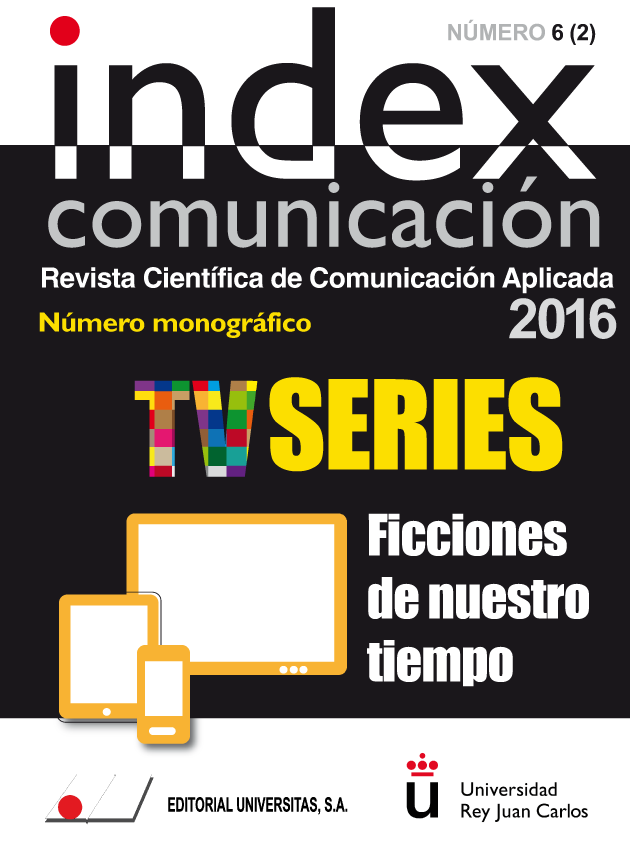White is the New Black: Interweaving Axes of Discrimination in ‘Orange is the New Black’
Keywords:
Axes of discrimination, Gender, Intersectionality, Orange is the New Black, Race, TV SeriesAbstract
From a classical feminist view, Orange is the New Black (Netflix, 2013- ) –OITNB– is considered an innovative point of view on gender in the so-called Television's Third Golden Age. It has got this recognition through a diverse and complex representation of women experiences, with a great variety of bodies, ethnicities, and sexualities. However, the application of an intersectional perspective allows us to discuss these positive results: race is a source of stereotypes. Thus, using Content Analysis, the main objective is to examine how the ethnic families of OITNB are represented; how race interacts with other axes of discrimination social class, functional diversity, age, gender, sexual orientation, and religion; and to study how patterns of domination and oppression are reproduced. In conclusion, this production favours narratives of white women, so it is a portrayal of symbolic discrimination in reference to other racial experiences.Metrics
References
Aguado Peláez, Delicia (2014): ‘Cuando el patriarcado sobrevive al apocalipsis. Análisis de The Walking Dead’, en Feminismo/s, nº 23, pp. 279-297.
Aguado Peláez, Delicia (2015): ‘La dominación simbólica sigue siendo cosa de hombres. Análisis de la supremacía masculina en Breaking Bad, Hijos de la Anarquía y The Walking Dead’, en Asociación Española de Ciencia Política y de la Administración, Actas del XII Congreso de la AECPA: ¿Dónde está hoy el poder? (pp. 1-19). Recuperado el 12 de marzo de 2016 desde: http://www.aecpa.es/uploads/files/modules/congress/12/papers/1195.pdf
Aguado Peláez, Delicia (2016): Cuando el miedo invade la ficción. Análisis de Perdidos (Lost, ABC, 2004-2010) y de otros Quality Dramas de la era Post 11S. Leioa: Universidad del País Vasco.
Aguado Peláez, Delicia y Martínez García, Patricia (2015): ‘Otro arquetipo femenino es posible. Análisis de Orange is the New Black’, en Miguel Hernández Communication Jounal, nº 6, pp. 261-280. Recuperado el 13 de marzo de 2016 en: http://rev.innovacionumh.es/index.php?journal=mhcj&page=article&op=view&path[]=93&path[]=220
Butler, Judith (2002, ed. en castellano): Cuerpos que importan. Sobre los límites materiales y discursivos del sexo. Buenos Aires: Editorial Paidós.
Chávez, Michael (2015): ‘Representing Us All? Race, Gender and Sexuality in Orange is the New Black’, en All Theses, Dissertations, and Other Capstone Projects, Paper 422. Minnesota: Minnesota State University, Mankato.
Collins, Patricia (1990): Black Feminist Thought. Knowledge, consciousness and the politics of empowerment. London: Routledge.
Collins, Patricia (2012): ‘Rasgos distintivos del pensamiento feminista negro’, en Jabardo, Mercedes (ed.): Feminimos negros. Una antología, pp. 99-134. Madrid: Traficantes de Sueños.
Crenshaw, Kimberlé (1989): ‘Demarginalizing the intersection of race and sex. A black feminist critique of antidiscrimination doctrine, feminist theory and antiracist politics’, en University of Chicago Legal Forum, pp. 139-167.
Crenshaw, Kimberlé (1991): ‘Mapping the margins. Intersectionality, identity politics, and violence against women of color’, en Stanford Law Review, nº 43 (6), pp. 1241-1299.
Crenshaw, Kimberlé (2012): ‘Cartografiando los márgenes. Interseccionalidad, políticas identitarias, y violencia contra las mujeres de color’,en: Platero, Raquel (Lucas) (ed.): Intersecciones: cuerpos y sexualidades en la encrucijada, pp. 87-122. Barcelona: Ediciones Bellaterra.
Cruells, Marta (2015): La interseccionalidad política: tipos y factores de entrada en la agenda política, jurídica y de los movimientos sociales. Barcelona: Institut de Govern i Politiques Públiques de la Universitat Autónoma de Barcelona.
Faludi, Susan (2009): La pesadilla terrorista. Miedo y fantasía en Estados Unidos después del 11S. Barcelona: Anagrama.
García, Javier y López, Alicia (2015): ‘Orange is the New Black. Una visión antropológica’, en Revista de la comunicación de la SEECI, nº 35, pp. 19-33.
Granzka, Patrick (2014): Intersectionality. A foundations and frontiers reader. Philadelphia: Westview Press.
Lombardo, Emanuela y Verloo, Mieke (2010): ‘La interseccionalidad de género con otras desigualdades en la política de la Unión Europea’, en Revista Española de Ciencia Política, nº 23, pp. 11-30.
Menéndez, María Isabel y Zurián, Francisco (2014): ‘Mujeres y hombres en la ficción televisiva hoy’, en Anagramas-Universidad de Medellín, nº 13 (25), pp. 55-72.
Piñuel, José Luís (2002): ‘Epistemología, metodología y técnicas del análisis de contenido’, en Sociolinguistic Studies, nº 3(1), pp. 1-42.
Platero, Raquel (Lucas) (ed.) (2012): Intersecciones: cuerpos y sexualidades en la encrucijada. Barcelona: Ediciones Bellaterra.
Platero, Raquel (Lucas) (2014): ‘¿Es el analisis interseccional una metodología feminista y queer?’, en Mendia Azkue, Irantzu; Luxán, Marta; Legarreta, Matxalen; Guzmán, Gloria; Zirion, Iker, y Azpiazu Carballo, Jokin (eds.): Otras formas de (re)conocer. Reflexiones, herramientas y aplicaciones desde la investigación feminista, pp. 79-95. Donostia-San Sebastián: Insituto Hegoa y Diputación Foral de Gipuzkoa.
Platero, Lucas (2015): ‘¿Por qué nos gusta tanto la serie Orange is the New Black?’, en VV. AA.: Sexo, mujeres y series de televisión, pp. 77-94. Madrid: Continta me tienes.
Ruiz Olabuénaga, José Ignacio (2012): Metodología de la investigación cualitativa. Bilbao: Universidad de Deusto.
Young, Iris Marion (2000): La justicia y la política de la diferencia. Madrid: Ediciones Cátedra.
Downloads
Published
How to Cite
Issue
Section
License
Authors who submit to this journal agree to the following terms:
Authors retain copyright and ensure the magazine's right to be the first publication of the work as licensed under a Creative Commons Attribution-NoComercial 4.0 International License that allows others to share the work with an acknowledgment of authorship of the work and the initial publication in this magazine, with no commercial purpose.
Authors can establish separate additional agreements for non-exclusive distribution of the version of the work published in the magazine (for example, to an institutional repository or publish it in a book), with an acknowledgment of its initial publication in this journal.
It allows and authors are encouraged to disseminate their work electronically (eg, in institutional repositories or on their own website) prior to and during the submission process, as it can lead to productive exchanges, as well as a citation more early and most of the published work (See The Effect of Open Access).















